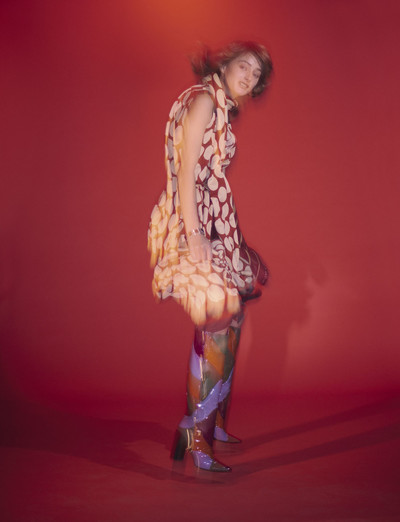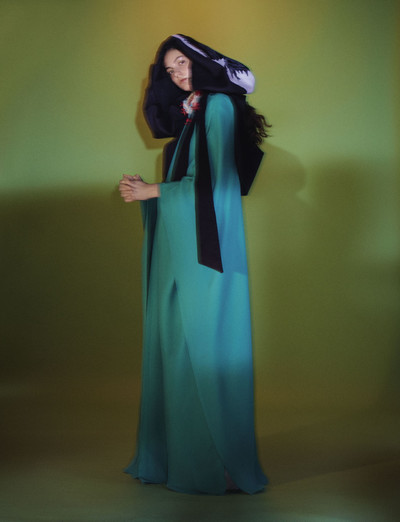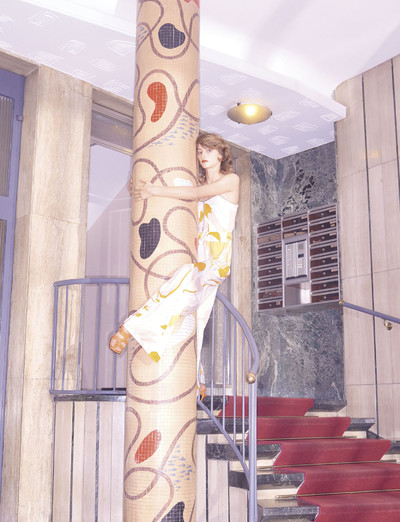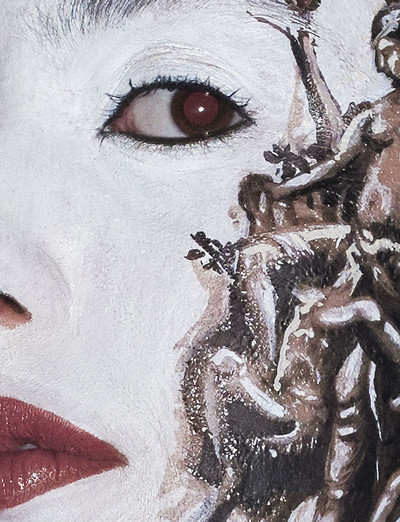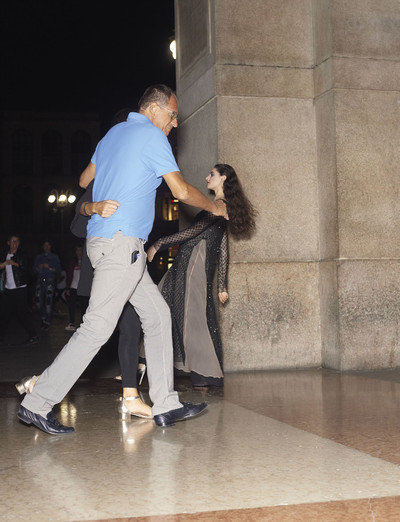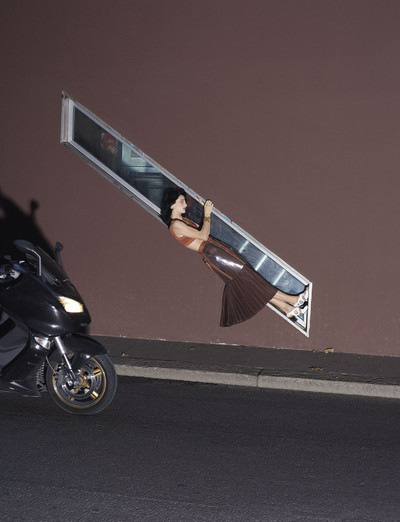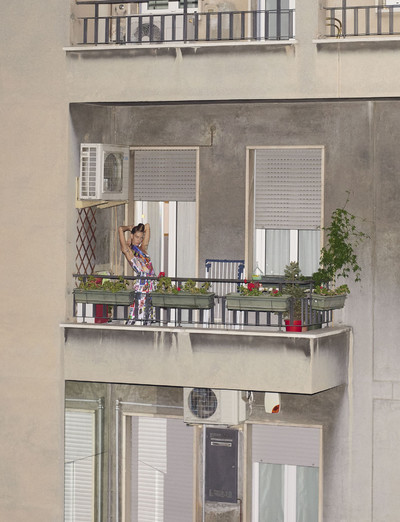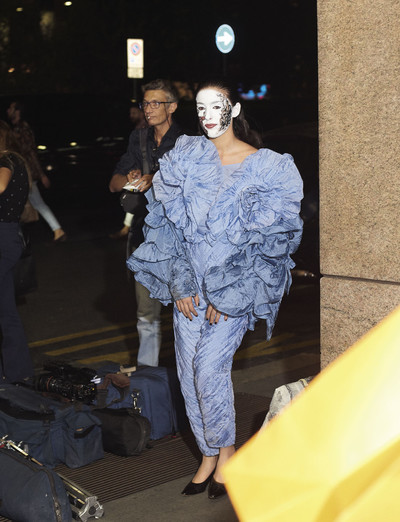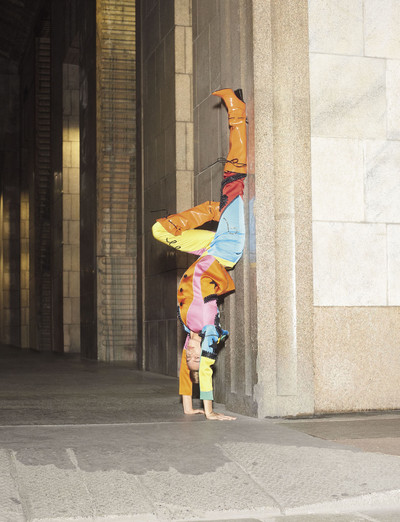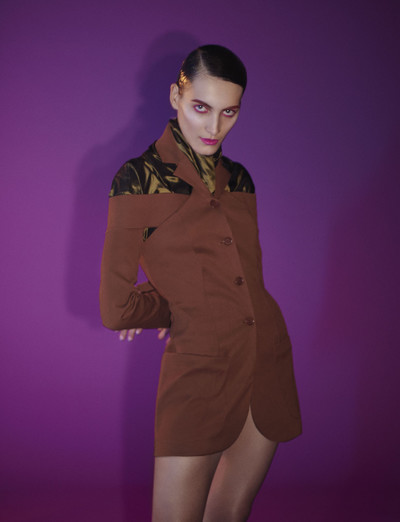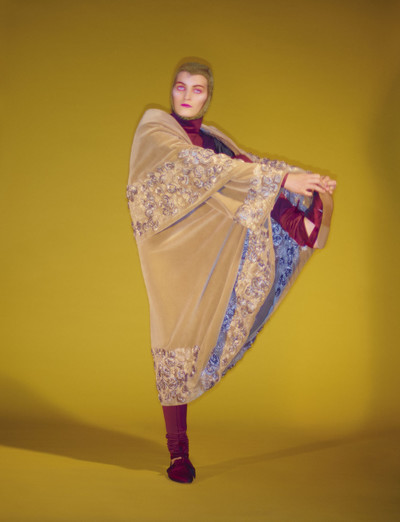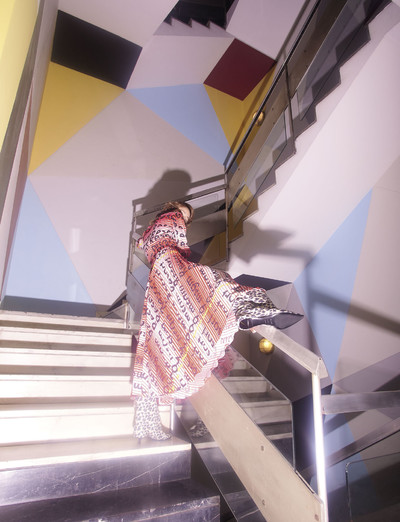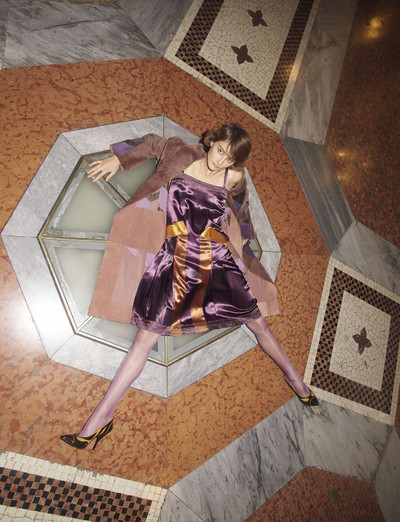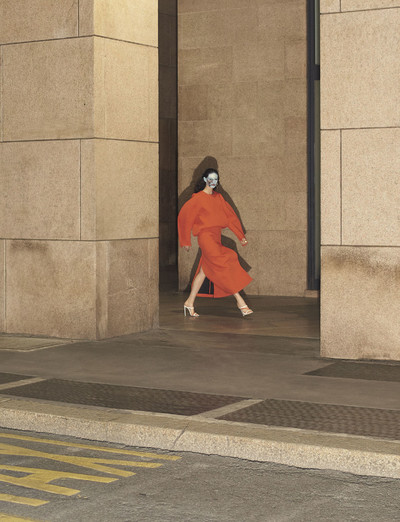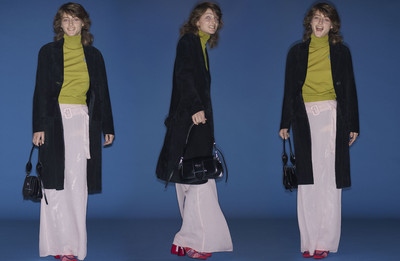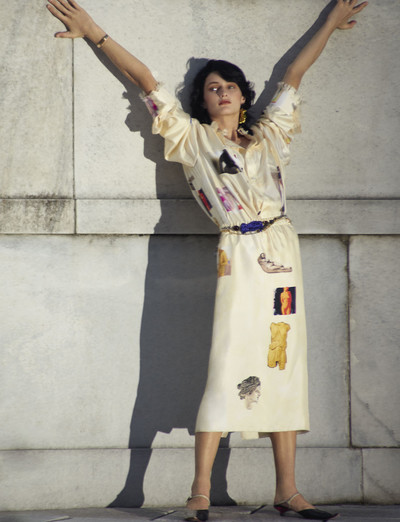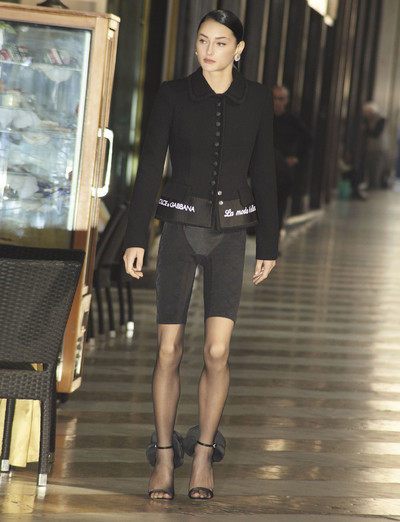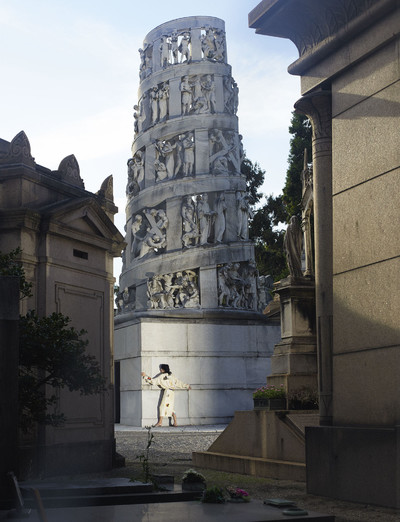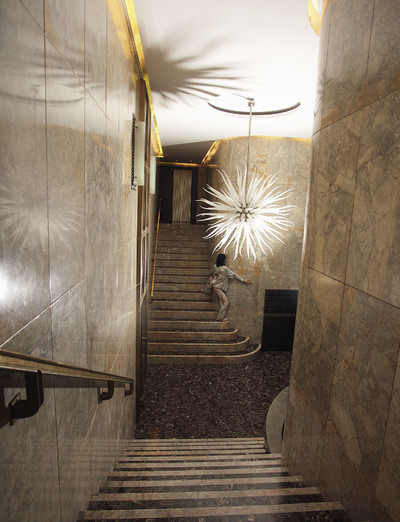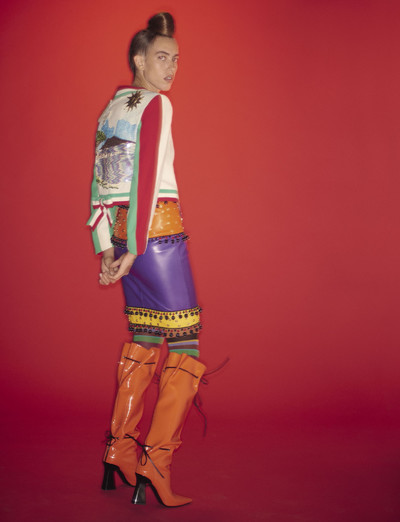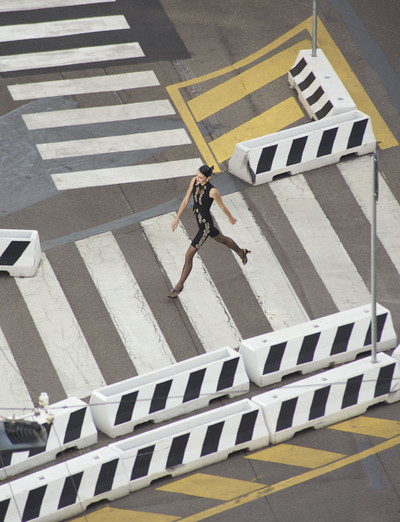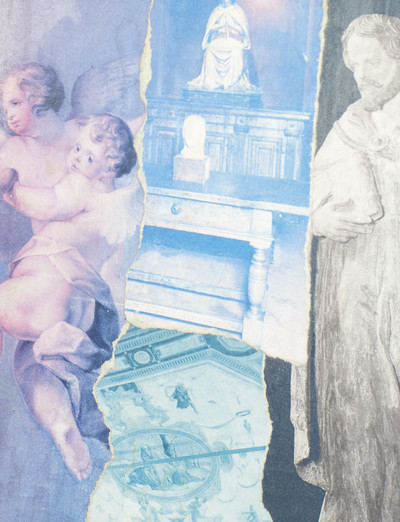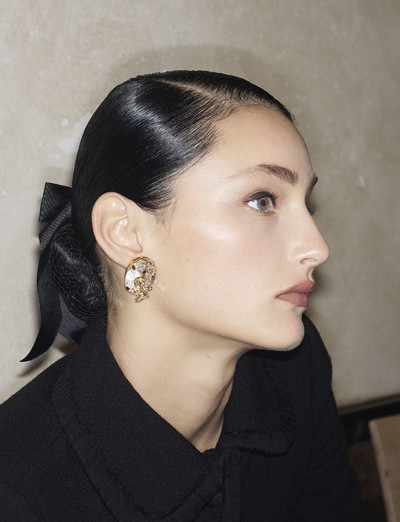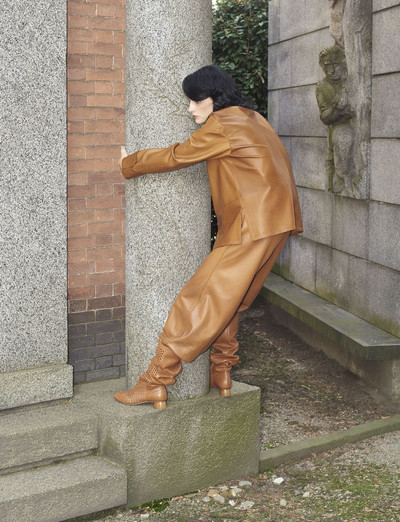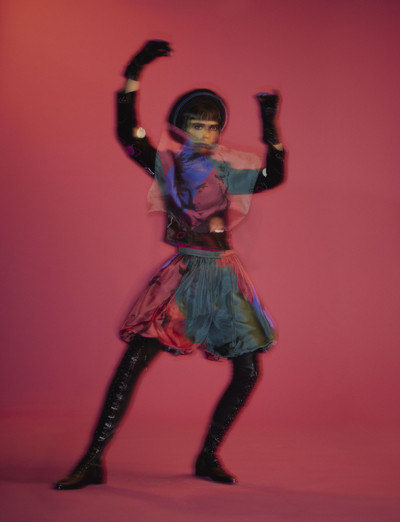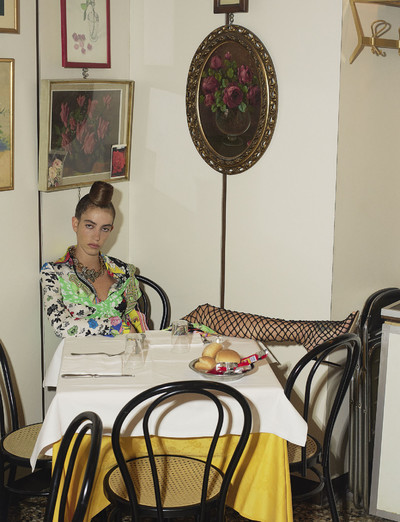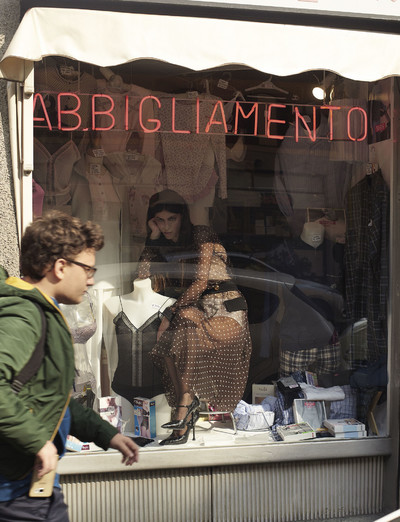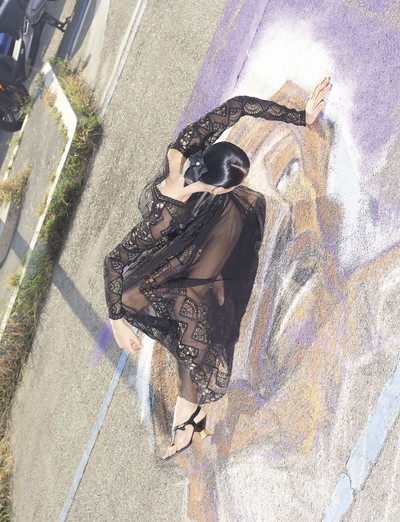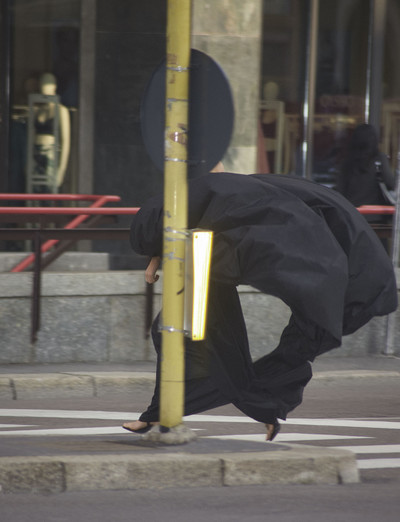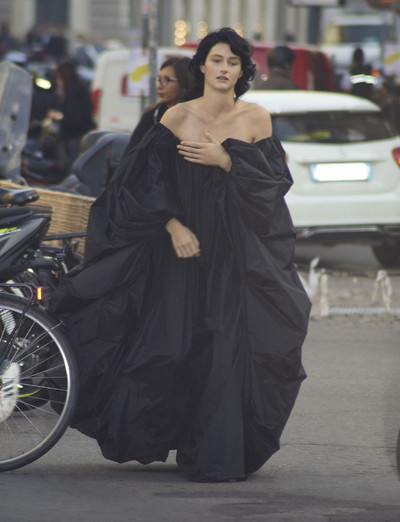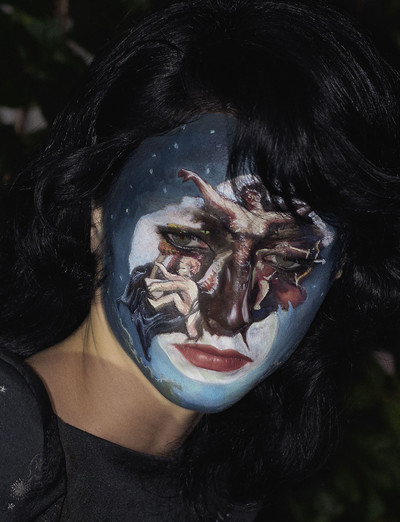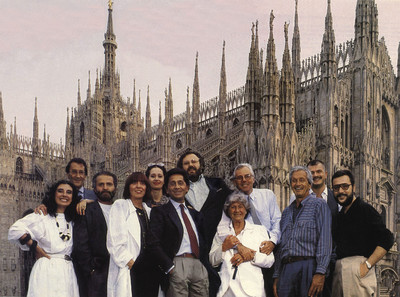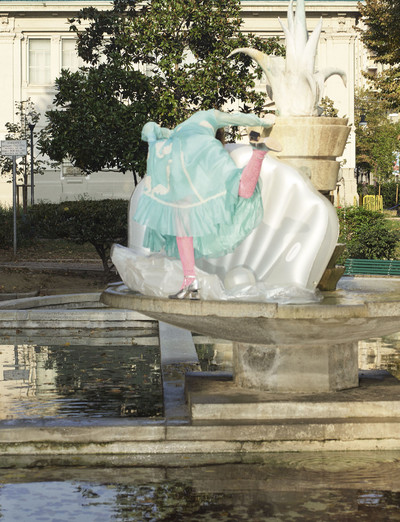Angelo Flaccavento, Italy’s most authoritative (and opinionated) voice in fashion journalism, gets vocal.
By Jonathan Wingfield
Photographs by Johnny Dufort
Styling by Lotta Volkova
Angelo Flaccavento, Italy’s most authoritative (and opinionated) voice in fashion journalism, gets vocal.
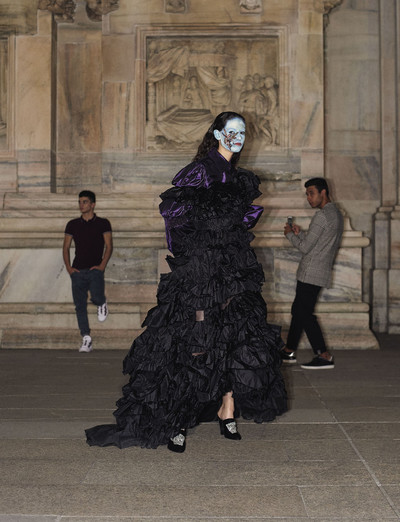
‘Paris Fashion Week which closed yesterday lasted for too long and provided little pleasure.’
(The Business of Fashion, October 3, 2018)
Angelo Flaccavento tells it like it is. The Sicilian journalist has been writing about fashion for almost 20 years, and if you’ve never come across his show reviews and industry reporting – principally for Italian daily business newspaper Il Sole 24 Ore and digital platform the Business of Fashion – then you’re missing a treat. Or escaping torture, depending on whether you find yourself on the receiving end of his no-nonsense, hit-’em-where-ithurts prose. Because in today’s era of native content, puff-pieces and general editorial fluffiness, Flaccavento serves up eye-watering missives that are as startlingly honest and unvarnished as they are likely to reveal fashion’s inconvenient truths.
Not that Flaccavento relies on bitchiness to gain attention. The erudite authority and knowingness that his writing exudes is light years away from the social-media vitriol driving much of today’s op-ed commentary. And while throwing industrial, political or societal context into a critique about a hemline or silhouette might on paper (or screen) sound like a recipe for pompous disaster, Flaccavento possesses a self-awareness and sense of pragmatism that reads more like an impassioned ‘Can’t we all do better than this?’, rather than oneupmanship delivered from fashion’s ivory tower.
In particular, it’s Flaccavento’s evaluation of Italian fashion – past, present and future – that distinguishes him as a vital resource for the industry. Fashion in Italy is unquestionably at a crossroads right now. Gucci continues its prolific turnaround growth, based largely on a marketing-heavy shift towards product diversity and behavioural inclusivity. Prada, meanwhile, preserves its inherent stylistic and intellectual elitism (for an industry that rightfully adores the house), all while navigating the scale and democratisation of the digital age (for an emerging consumer that’s yet to make up its mind). If Italian fashion remains synonymous with empires and dynasties, then right now it feels like a particularly exciting episode in a long-running sceneggiati (soap opera): Valentino’s succession plan is a shining light of grace and intelligence; Fendi selling itself to French conglomerate LVMH has certainly paid off; while the fortunes of Versace, Armani, Missoni, et al., remain very much unresolved. Even Italy’s proud history of craftsmanship and formal tailoring, exemplified by the ‘Made in Italy’ seal of approval, all seem desperately at odds with the global rise of streetwear and sneakers.
With all this swimming through our minds, System has spent the past couple of seasons in the company of Angelo Flaccavento. We sat down to record conversations with the Sicilian that bookend a six-month period: firstly, on the eve of Autumn/Winter 2018 Milan Fashion Week back in February, and more recently the morning after Gucci’s Spring/Summer 2019 show (the one which closed the Milan season, yet bafflingly took place in Paris) in September. What follows is Flaccavento off-duty: historically on point, naturally curious, dry, always opinionated, and good company. Meanwhile, stylist Lotta Volkova and photographer Johnny Dufort took to the streets of Milan to shoot a photographic survey of Italian fashion from A(rmani) to Z(anotti).
Part I
Milan
February 20, 2018
Jonathan Wingfield: A beginner’s question to start with. Why and how did Milan emerge as Italy’s fashion capital?
Italian fashion as we know it was born in 1951. Marquis Giovanni Battista Giorgini invited American buyers who were visiting Paris over to his home in Florence to purchase Italian-made garments. Fast-forward to the early 1970s and there was a move from Florence – where Pitti had become the focal point of Italian fashion – to Milan, where the foundations were established for what would become the prêt-à-porter shows. These shows really started to flourish in around 1976, 1978, but the likes of Missoni, Krizia and Walter Albini had been showing in Milan since 1971.
Tell me more about Walter Albini. He was a pivotal figure at the time, but never really became a household name.
Although he died very young, Albini is considered the grandfather of Italian fashion. He initiated what we now recognize as Milan’s prêt-à-porter shows, but was literally too ahead of the times to reap the benefits. He was a freelance designer who’d worked in different capacities for different brands: designing raincoats for one brand that was working with one particular manufacturer; knitwear for another brand with another manufacturer; skirts for another. In 1971, he assembled all these different pieces as a collection and presented it under his own name in Milan at the Circolo del Giardino, rather than going to Pitti in Florence.
‘Fashion became such a huge phenomenon in 1980s Italy, because it filtered all the way from the top of society down to the common man and woman.’
Designing for multiple brands was quite common at the time though, right? Giorgio Armani was doing that before starting his own label.
Yes, but Albini was the first one to bring these things together under his own name. He projected himself as the auteur of the collection, while the manufacturers became the producers. So, for the first time, it was more about the Italian designer presenting his vision for the forthcoming season.
What kind of image was he projecting through his brand?
Albini was incredibly vain, but in a charming way. His aesthetic was very 1920s, very Great Gatsby, very languid and nostalgic. He also did beautiful drawings. He famously staged a show at the Caffè Florian in Venice, and had a beautiful showroom space that he created here in Milan, in the Art Deco district right behind the Parco Montanelli. It was completely covered with mirrored tiles and quite exquisite. He was constantly changing his aesthetic: at one point, one of his houses had raw concrete on the floor and rubber curtains. He once did a men’s collection without actually designing any clothes; he just borrowed stuff from his friends and created looks. That was typical of the late 1970s.
A radical time.
Designers were expected to be radical, because customers at the time were daring enough to buy those strong statement pieces. In fashion today, the show is often just showmanship. That’s why I respect designers like Rick Owens or Rei Kawakubo: crazy stuff on the catwalk, crazy stuff in the shop – and it sells. But then there are all those designers doing crazy shows, but whose shops are full of navy-blue jackets. It makes no sense.
Let’s go back to the emergence of Milan as Italy’s fashion capital.
What’s key to understand is that the industrial manufacturers have been mostly situated around here, in the north. Italy is a land of comuni [districts], and historically there have been districts specialized in a particular sector of production. The area around Carpi is known for knitwear; shoes in Italy are made either in the Brenta, which is towards Venice, so not far from Milan; fabric industries are around Milan and Como with the silk and the printers, and the wool mills in Piedmont. So it is basically throughout this region, with Milan as the central city.
So the marriage of industry and design brought fashion to Milan?
Milan has always been a city of design; it’s a symbol of progress. If you divide Italy into just two cities, you have Milan in the north and Rome as the entry towards the south. Rome represents the past – it’s always been there, but has no sense of momentum – whereas Milan is about modernity and speed and industry. Being Italy’s northern city, it is also closest to the rest of Europe. Milan is a mindset; everything happens very fast here, and that is how fashion first flourished here, in the late 1970s and early 1980s.
Was Italian industry as a whole booming at the time?
Like in Great Britain, the 1970s were a very difficult time in Italy, defined by political uproar and deep recession. Milan itself could be very dangerous because, like most big cities in Italy, there were frequent terrorist attacks. But as the country emerged from that period, in the early 1980s, there was a lot of money around and, all of a sudden, fashion in Italy became synonymous with the status of success. People were keen to show what they were earning, which meant the car you drove, the house you lived in, and, crucially, what you wore. Fashion became such a huge phenomenon because it filtered all the way from the top of society down to the common man and woman. Everybody was in tune with what was happening in fashion, in ways that no longer exist today.
How did this affect your own family?
I grew up in Ragusa, a small town in the south-east of Sicily. I got interested in fashion very quickly because my relatives – the sister and the brother of my father – owned high-end boutiques, catering to the affluent local clientele. These small towns in Sicily and elsewhere in Italy were where Italian designers made their money in the 1980s because people were so eager to spend incredible amounts on the latest fashions. I remember my uncle and my aunt themselves spending tons on clothing.
‘Walter Albini once did a men’s collection without actually designing any clothes; he just borrowed stuff from his friends and created looks.’
What were they buying?
Versace, Missoni, Valentino, all the glitzy stuff. We are Italians and we like to show off!
How were the designers regarded in Italian society, and in the media?
They were constantly on television and in the newspapers, giving their opinion on everything – politics, society, not just style and clothing. But that also helped to create a sense of mythology around them that today’s designers no longer have, probably because the way we communicate now is so different. These days anyone can send Alessandro Michele a direct message on Instagram; back then, the designers were strictly off limits, protected by a shield of muses and publicists. They really were the new emperors, and behaved accordingly. I mean, think of Gianni Versace, whose persona was almost like a Roman emperor. Or Valentino in Rome.
Yes, let’s talk about Rome. I’m particularly interested in the relationship between Rome and America, and how that laid the foundation for Italy’s reputation as being stylish and producing stylish clothes. There’s this clichéd perception that Hollywood movie stars would come to Rome in the 1950s and 1960s to shoot at Cinecittà, go shopping at Gucci on their days off, and end up promoting Italian style to the whole of America.
Well, that’s about right. Rome was two things: haute couture and cinema. Cinecittà was such an active studio, they were filming big American productions like Cleopatra there. I think that Italian
fashion has always needed to be channelled through something inaccessible or dreamlike in order for it to really capture people’s imaginations. These days, of course, that means influencers, who are the most democratic manifestation that, but back then, it was untouchable movie stars. I remember my mother telling me that you’d see a look in a movie, then go to a local seamstress or tailor and get them to replicate it for you.
Would you say that link between Italian fashion and American stardom has endured?
We’ve always used American inventions like cinema and advertising to project an idea of Italian fashion. Certainly, if you think about what American Gigolo did for Armani. That was 1980, and the
film’s American director Paul Schrader chose to dress this new male archetype in a way that was kind of formal but informal. Richard Gere’s character was a man who studiously took care of both his appearance and his body. Schrader dressed him in Armani because it exemplified a sense of modernity: soft tailoring, and having everything from his neck tie to his blazer in the same shades.
What about womenswear?
In the movie Working Girl, when Melanie Griffith transforms from a Staten Island girl into a career woman, she comes out dressed in Armani, too. She starts that film looking very American with big hair and big shoulders and then when she becomes refined, she is dressed in a grey Armani suit and looking very understated.
Let’s talk about advertising. In the 1980s here in Italy, fashion advertising exploded; it felt like all the Italian brands were hiring top American photographers and adopting big American marketing schemes to show the world what they could do. It was ostentatious, and it worked.
At the time, Italian fashion was all about the union of the designers, the textile mills and the manufacturers, so you’d have six different factories each paying a chunk of the advertising for a brand. Everyone understood the power of advertising, because it was another example of American culture being good for business. I mean, if you look at those Versace images by Avedon, they remain so powerful today.
Armani’s original advertising too remains very potent, very heroic.
That Armani advertising was done on a shoe-string budget, but with the aim of creating these timeless black-and-white movie stills. The clothing was modern, but the imagery was almost nostalgic, and it was a highly successful mix. If you consider all the stylists and image-makers and art directors operating today, it’s hard to think of any advertising in recent years that’s reached that level of sophistication and quality…
‘In Working Girl, Melanie Griffith starts with big American hair and big shoulders and then when she becomes refined, is dressed in a grey Armani suit.’
…and success.
I think that Italians are very good at selling in that sense. It goes back to Albini and his vision for a lifestyle. Italians had the intuition that if you wanted to successfully express the fashion dream, then you had to create imagery. Being featured in a fashion magazine’s editorial shoot wasn’t enough – you had to create your own imagery, your own advertising.
You mentioned before that Armani was considered by Americans as ‘understated’ and it does seem at odds with the Italian culture of peacocking.
I think Italians are born peacocks. It’s deeply rooted in our culture, probably from the Catholic culture of Sunday best. Mass on Sundays is a moment of community that’s extremely hierarchical, and hierarchy is expressed through the way you present yourself.
Do you think there is an inherent conservatism to Italian society and how it presents itself?
Absolutely, we are quite conservative because we have a fear of what challenges perception. Being Catholic makes us very conformist and so you maybe have your wild moments when nobody’s looking, but publicly, you comply to the code. Unlike Great Britain, Italy is not a place of subcultures. For us, it is more about showing off than belonging to a movement and creating an opposition through what we wear.
Have there ever been subcultures in Italian society?
The only one specifically tied to clothes was the Paninari in the 1980s which, unsurprisingly, was all about showing off. These days, it has been mythologized and looks ‘nice’ and not at all subversive. But do we have subcultures in the British sense? No. I guess you can occasionally spot people’s political preferences by the way they dress, but it is rare.
When you consider what many of the Italian fashion houses are now proposing stylistically, it feels like the Italianness of Italian fashion has been sidelined.
Absolutely. I can barely see anything Italian in Italian fashion right now. I sometimes think we are somehow desperately trying to regain a national identity, as if that is what’s needed to boost the industry.
That sounds like Brexit fashion.
Well, it brings up an interesting question: Is it still relevant to talk about national characteristics in fashion? I mean, what is French fashion today? It doesn’t exist anymore. Paris perpetuates its reputation for being an international fashion hub, with Japanese, Belgian, British and Italian designers all mixed together, delivering diverse expressions of avant-garde and radical thinking. But its cosmopolitan-ness has eclipsed any French-ness. Compared to Paris, Italian fashion is far more insular. Historically, it is quite rare that we have foreign designers coming to show in Milan. Issey Miyake showed his menswear here for a while, but if you think about what Paris has represented for Yohji and Comme over almost 40 years, it’s not comparable.
What about foreign designers working for Italian houses? At one point recently, there was talk of a foreign designer coming to work for Versace.
For me, it is difficult to imagine a foreign designer ever doing Versace. If you’re talking about Italian identity – which certainly plays a part in the Versace brand – then you have to know that Italy is a place of contrast. Crudely put, there is Armani for the fashionable woman who doesn’t want to scream fashion as she walks down the street, and then there’s Versace for the sensual woman who wants to scream her sensuality and her being fashionable while she walks. They are both Italian, but I cannot imagine a British or an American designer understanding the many subtle nuances that exist within Italian style, society and fashion.
So maybe Donatella Versace already has her successor tucked away in her design studio, and just doesn’t know it yet.
Well, the Gucci case was proof that maybe the next one is not a known name, because when Alessandro Michele took over everyone was like, ‘Who on earth is this guy with the Jesus Christ look?’
Did you know much about him?
He was part of the team, like the righthand man to Frida Giannini. But what’s happened there is great – whether you like what Gucci is currently doing or not in aesthetic terms, it is a genuine reflection of Alessandro Michele’s taste. You can see that it is not made up. He just lives that kind of look. I think it was visionary on the part of the CEO to give him that opportunity, and not go with a more obvious ‘star’ designer. Those ‘star’ names that circulate are always the same few.
‘Italians are born peacocks. It’s deeply rooted in our culture, probably from the hierarchical Catholic culture of Sunday best.’
I suppose the all-important message is slightly underwhelming when you have to ask ‘who?’, as opposed to saying ‘Ahhh!’
Yes. I think as Italians we also have to rid ourselves of this inferiority complex that we have to other countries, Britain in particular. If you are a stylist with a British name here then you work a lot; if you are a good stylist here but with an Italian name, then you won’t work. It is very strange. We like what comes from abroad, it looks cooler, even if it is the same as what’s here. It comes back to the idea of wanting a projection of Italy through an American lens.
And yet conversely the idea of ‘Made in Italy’ remains universally appealing.
And it is written in English because the power of ‘Made is Italy’ is better perceived abroad.
When did people start sewing ‘Made in Italy’ labels into Italian clothes?
I think that as a marketing device, it emerged in the 1970s thanks to Giovanni Giorgini, the guy who sought to promote Italian fashion. The reality goes back further of course, because Italy has historically always had very high-quality artisanal craftsmanship. But between the 1950s and the 1970s, we were able to transform artisanal into industrial. Italy is one of the only countries where this happened.
Italian textile factories seem to have a near-mythical status.
I love visiting them to see first-hand the Italian flare for creating things. I visited the Kiton factory in Naples and they stressed that everything is made by hand. Their suits cost thousands, so people maybe think, ‘OK, it’s all part of some marketing strategy to have a very high mark-up’; then you go to the factory and you see they have 100 or 200 tailors working. The Italians are very inventive, so the industries found a way to turn industry into something manual. My mother is from central Italy, a region well known for knitwear, and she was telling me that the industrial manufacturers lend their knitwear machinery to local women who work from home. The manufacturer then collects everything from the locals and put the labels in; it’s like ‘extreme artisanal’.
Would you say the ‘Made in Italy’ stamp has as much gravitas as it did, say, 20 years ago?
For a certain customer, yes, because it is a guarantee of quality. But for younger customers, far less so. I mean, fast fashion changed everything; it changed the mentality of people who buy designer fashion, because high fashion has adopted the modality of fast fashion – the need for constant drops.
Fashion’s never felt so ephemeral.
I remember in my aunt’s shop in Sicily, there were only two or three ‘drops’ a year – not that she called them that. She already had everything in stock; she just decided what to put out in the shop from the backroom. These days, your coat is only as good as the week it stays in the shop, then it is gone and so has its value. But for me, selling clothes and selling fashion are two quite distinct things.
Fashion is something higher for me, because buying a fashion item is creating a discourse about yourself and projecting it onto others.
Do you think it would be good for business for Italian brands to push their Italian-ness again?
I don’t know. Having a unified identity for Italian fashion today is anachronistic because we live in an age of fragmentation. Being Italian might be perceived as being monolithic and old, but we should also be more self-conscious, and stop trying to mimic other fashion weeks. These days, we are no longer avant-garde, but that is perfectly fine. You should just take the situation into your own hands and if you are worth something, I think that something positive will happen.
Ultimately, fashion, like everything else today is becoming increasingly homogenized.
Yes, and so you ask yourself the question, ‘Should Italy push Italian identity right now, or should we accept that being globally successful means making globally homogenized fashion?’ I mean, Americans express American identity, but unfortunately American identity is, for the most part, just about selling clothes. In design terms – apart from the odd outcast designer – it’s bland because they always just seem to be derivatives of something else.
‘When Alessandro Michele took over at Gucci, everyone was like, ‘Who on earth is this guy with the Jesus Christ look?’’
Where does Italian fashion sit within this?
It sits halfway between Paris and America. We know how to make nice clothes that sell, and we’re pretty good at marketing them, but we can also be inventors. That for me is why the 1980s remains such a mythological era for Italian fashion. It found that perfect balance between invention, product and a way of communicating a strong identity to the public. It is very telling for me that Moncler has chosen to name its current project Moncler Genius; I’d say that’s a nod to the Genius Group of Adriano Goldschmied, who was one of the inventors of Italian streetwear. Adriano Goldschmied was basically acting as an umbrella for different stylistic entities, and it was very interesting at the time.
Tell me about the new wave of Italian designers. Could you ever envisage a new set of fashion empires emerging?
I think that at some point today’s empires will start to crumble. But for the time being I don’t see new designers building new empires. I think most of them are happy to cultivate their own little space, which I think is a good way to express their vision. I mean, if you want to compete with the very big houses you need so much money, and to find that financing will just kill the creativity. A designer I really respect is Marco de Vincenzo. He is partly financed by LVMH because he is still the bag designer at Fendi, but I like that he is creating an identity and carving a niche at his own level, while also working for the mainstream. Lucio Vanotti, with his playful minimalism, is another one; I’ve asked him about the scale of company he wants to become many times, but he doesn’t want to get huge. He is happy with the clients that he has, and is happy to grow little by little each season.
Is there much support for Italian fashion on a state level? It has to be one of Italy’s largest exports.
It’s been a long story and not particularly linear one.
Why?
Italian institutions have sometimes promoted fashion in this big paternalistic way; promoting young talent, which is great, but paternalism means they don’t always choose the right talent. They’ll do quick-fire research and just pull out some people. The new generation of Italian designers needs to stop thinking that they’re victims of the older generation not giving them credit, and just own their own space, like what happens in London and Paris. Right now, there’s not much ‘I am here – look at me!’ I think there needs to be.
You mean, there’s not much arrogance of youth in Italian fashion.
I think that my generation or younger, we have a problem with growing up. In Italy, there is an inherent sense of respect for our elders; we prefer to still be the son or the daughter of someone. I think the big designers still see these emerging designers as really small and insignificant people. They are not little; their aspirations are just measured by what they think they can achieve. And I think it’s sad that none of them are saying: ‘Listen, I am here, I am young, and I have something more interesting to say than the older generation.’
They’d probably have to leave Italy.
Yes, I think it is deeply embedded in Italian culture, in all environments, even the academic environment. It is a circle that never ends: it takes such a long time for young people to become
established that by the time they do, they are old enough to have seen a younger generation emerge beneath them, and to consider them as a threat. So it goes on and on. It is very difficult for Italian people to take responsibility and act independently. That is why in Paris and London I get surprised by these designers who literally pop up from nowhere.
I think in London there is such a promotion of new talent that sometimes the promotion is more successful than the reality.
But with Italian fashion we need to learn how to do that. Tomorrow is the beginning of fashion week and three of the best new names are placed on the schedule between 9.30 and 11am. Albino Teodoro, Arthur Arbesser, who is Austrian but works in Milan, and Lucio Vanotti, who I just mentioned. But the Gucci [Autumn/Winter 2018] show is in the afternoon – it basically represents the start of the week – so only a few people will get to see these new designers. It’s a wasted opportunity…
…for the whole industry here.
We are not very strategic. Look at how in general, France promotes its cultural heritage and its monuments, and it really has a fraction compared to Italy. Italy is the only country where Italians themselves scribble graffiti over our old statues. We are so used to being surrounded by these things that we don’t care about them, and we don’t know how to promote them. Other places in the world have a single old column and have made a whole tourist industry around it!
‘If you’re a stylist with a British-sounding name then you work a lot here; if you’re a good stylist here but with an Italian name, you won’t work.’
Is there a sense of community in Italian fashion? Or is it very fractured, with empire after empire after empire?
It is fractured. I was not around to witness it first-hand but it looked more like a community in the late 1970s, early 1980s. There is one famous picture19 from 1985 in which all the Italian designers are stood together – arms around each other, all smiling – in front of the cathedral. It says a lot, you’d never see that today. Everything has become very insular and fragmented.
Yet despite the economically unstable times, the Italian fashion market continues to grow.
Absolutely. Fashion is still one of Italy’s principal industries, yet it has always been considered a little frivolous. I mean, the prime minister has only been attending fashion week in the recent years; it’s taken ages for that to happen. And in the media, if you look at newspapers’ advertising pages, they’re almost all fashion and beauty brands, yet journalists have to fight every fashion week to have any space in those same newspapers to print articles.
You mentioned Krizia earlier on. It’s interesting as it was a significant and influential house at the time, yet barely exists in people’s minds now. What led some Italian houses to become global businesses, while others faded?
There were so many houses that were big and have fallen. Look at the way Gianfranco Ferre completely and criminally folded. I think the deciding factor behind any Italian fashion brand’s success or failure is that as Italians we remain attached to the idea of the family business. So the family business is all about the patron, the boss. And I think that no matter how hard you try, you are only truly modern just once in your life. It seems impossible to sustain or, worse still, replicate that particular moment.
Dare I ask you to give me an example?
I respect Miuccia Prada immensely, but I do not consider her so modern any longer. Of course, she’s had a huge impact on fashion, but the more success you get the more you get pushed into the ivory tower, and the less you see out onto the real world. I think designers often observe the world through the lens of the people close to them who report back to them. So they lose touch in a way. Designers give their best when they are poorer: think about what Nicolas Ghesquière was doing at Balenciaga when there was such limited budget.
Your point about only being modern once brings us to the current idea of fashion nostalgia, none more so than Versace’s big Gianni Versace homage last year.
I think I was one of the only few who didn’t particularly like that tribute collection. It was very smart businesswise and it was very emotional, but the true emotion that hit me was one of melancholy. And so I wrote that very clearly in my review. I had a meeting with Versace about the review because they
thought that I’d had a preformed opinion about Donatella going into that show, which is absolutely not true. I respect her immensely as a designer and as a human being, and I think she has done a terrific job in the past. Of course, I am not in her shoes, and having a figure such as Gianni Versace in the background must be very hard to cope with emotionally and professionally. But for me, doing this tribute collection was like admitting: ‘OK, I will always be a little smaller, a little less of a genius.’ Moving things forward by reconsidering the past is nothing new, but replicating the past, 20 years on, is dangerous because nothing’s ever the same: bodies are different, models are different, everything’s moved on.
What about Dolce & Gabbana, which seemed to emerge so quickly in the early 1990s?
They emerged with a vision of masculinity and femininity that was grounded in their Sicilian origins, but made modern. When they first started menswear, it looked quite mafia but done in a very interesting way. It was metropolitan and looked very appealing, so all of a sudden dressing like a shepherd from Palermo looked cool; you’d see people in New York dressed like that. They are still doing this Sicilian thing today, but I personally feel that it has become too kitsch. It is all about the decoration and the correct earrings and that kind of stuff. They were really an expression of Italian sensuality – very proud, but not too brash or vulgar – and they didn’t need to decorate, because it was all about the black dresses and black suits and white shirts, and it was always very powerful. But of course, if you choose a niche, like being inspired by Sicily, you cannot go on forever, and at some point you have to get out of that. Ultimately, I think that when designers feel they are losing relevance they cling to things and can’t deal with the changing times.
‘As a designer, no matter how hard you try, you’re only truly modern once in your life. It’s impossible to sustain or replicate that particular moment.’
Will that dynamic will define the immediate future of Italian fashion?****
Italian fashion is always torn between nostalgia and progress. It’s about navigating memories of big success, the desire to replicate that moment, and the difficulty of acknowledging that the moment has passed and times have changed – that is one of the diseases of Italian culture in every field.
What about succession in family businesses?
If the family business is properly managed, it means that the father or the mother will hand the reins over to the next generation. But when they do so they need to step back, not hand over the power but then stick around and continue directing.
What will happen to houses like Prada or Armani that have been so successfully steered by the mind of the boss?
That could become a big problem, because you strongly identify those houses with the identity of the founder. Even if these people are not really designing anymore, they are like a deity. Honestly, I don’t know what will happen.
We haven’t talked about Valentino at all, which feels like a good example of Italian fashion successfully evolving.
Absolutely. I think it has been done with brains and heart. What Pierpaolo [Piccioli] is doing now – both in prêt-àporter and couture – is completely relevant. He has been there long enough to understand the core values of the house, but he is also an individual so he knows how to push his own buttons inside the house and contextualize them within the present. Pierpaolo did a number of very smart things. Firstly, he brought Valentino out of the colour red; red was always the house colour, but now you identify Valentino with a broader palette. Secondly, when you now see a dress that is very flowy but not super big – a kind of spiritualized silhouette without looking like a nun – you think of Valentino. Whereas in the past when you thought of Valentino, you only really thought of big bows and big skirts. And thirdly, the Valentino clientele was historically all about Latin American socialites, but Pierpaolo is now catering to another audience. And he’s made these changes in light and poetic ways. It’s a real achievement.
Tellingly, it’s the Italian houses that relinquished family control and were acquired by French conglomerates – namely Kering with Gucci and LVMH with Fendi – that are faring best today.
Yes, there has been a huge shift. What those conglomerates have created reflects what is happening in broader society. Wealth and power have become concentrated into very few hands, and so the likes of Fendi and Gucci have become so big that they can literally do anything. That has made the small houses even smaller, with smaller means and smaller amounts of power with which to communicate their image and their products. Even Armani, a house that continues to exude a certain power, feels relatively small compared to LVMH or Kering. The creation of these conglomerates has somehow polluted the system in Italy, and probably everywhere else. It’s created a culture of flexing muscles and showing off power.
And it isn’t always a win-win for brands operating within those groups.
It has certainly put an emphasis on having to perform very well. Other brands flourished in their heyday in a more natural way, whereas today it is all about marketing. But of course, the capitalist trajectory is very straightforward – you can only grow or collapse, there is no third option. So, when you grow, you have to make your decisions. At Krizia, for example, Mariuccia Mandelli refused that kind of trajectory.
Do you think that the success of Gucci can be sustained?
I have no crystal ball. I think the Gucci success will last a bit longer, but all of a sudden it will stop, as things always do in fashion. This is even more likely to happen because Gucci’s current style is based on repeating the same stylistic tropes, season after season. So at some point, the public will inevitably get fed up, and will be like, basta.
‘Even Armani, a house that’s always felt powerful, and continues to exude a certain power, feels small compared to the likes of LVMH or Kering.’
That idea of successfully repeating one’s stylistic tropes feels particularly true of some Italian brands like Armani and Dolce & Gabbana. Whereas Prada…
…created the era of sudden change every six months. But to be honest, Miuccia Prada has always been very smart because that is what is perceived on top – it’s the foam on the cappuccino. The core of Prada for me is going to the shop and looking how the clerks are dressed – that is Prada. They look like teachers, you know: pleated skirts, turtleneck or cardigan, and men in suits. The basis is always very bourgeois, a very Swiss college aesthetic, but of course, what we love Miuccia for is the crazy fashion statements. And she can do the crazy stuff because of the bourgeois stuff, and the luggage being very consistent and reassuring and solid.
That seems to neatly symbolize Miuccia Prada’s relationship with her own family business.
Absolutely. She can go bonkers sometimes, but the luggage and the pleated skirts and the fine cashmere will always be there.
What would you say was an example of a well-maintained Italian family fashion business?
A brand I respect is Missoni. They’ve sustained the sense of that family business. Of course, there have been multiple rumours about them selling a stake of the business, and I think that might happen soon, but I have been to the factory and it is amazing because they have kept things afloat as they were for a long time. I mean, the brand is more than 50 years old, but they still do everything there – the factory and Rosita’s house in the same park. But as I said, at one point if you want to become a real player in the global market you have to take that position, or you stay small and super niche, which I personally think is the right way forward for some brands. You keep afloat, but you’re not making billions.
But it feels like in fashion today, you’re not a true player until you’re a billion dollar business.
But what can you do with all those billions? A lifetime can now last 85, 90 years. Of course, you can become part of that whole machine, but that machine kills everything because it is not about French fashion or Italian fashion any more – it is just about selling clothing. And while Gucci is the main trendsetter and powerhouse right now, the real power in Italian fashion remains the fact that we are hands down the best manufacturers in the world – for that kind of product at that kind of level. And all those people who bitch about Italy and say they don’t like the fashion here – well, those British designers and the French designers still come to Italy to produce their product.
Hallelujah! And finally, on the eve of a new fashion week in Milan, how do you feel about the prospect of it?
I always start fashion week in the hope that it will be the most surprising thing I have ever witnessed in my career. I never come here with a blasé attitude; if I started to think like that I would do something else professionally. What keeps me interested is the excitement of seeing something new, something made differently, something that makes me change my opinion, or simply, something that makes me think.
‘We love Miuccia’s crazy fashion, but Prada’s core is its shop clerks dressed like bourgeois teachers: pleated skirts, cardigans, and men in suits.’
Part II
Paris
September 25, 2018
Although it’s only six months since System last sat down with Angelo Flaccavento, it feels like an eternity. Such is the relentless pace of fashion’s current inter-season activity, the hirings and firings within the industry, and the brooding influence of world politics beyond clothes and the catwalk.
With Gucci shifting its Spring/Summer 2019 show location from Milan to legendary Parisian nightspot Le Palace, it was in the French capital that System reconvened with Flaccavento for another chat. Fresh from attending Milan fashion week (which he summarised in his Business of Fashion wrap-up feature with the opening line, ‘Milan fashion week keeps suffering’), it felt like another ideal opportunity to hear some opinionated opinion.
It’s been a season since we last spoke. What does a fashion season actually mean these days?
Of course, the very concept of the season is breaking up, but these big fashion months still feel like the pillars of the whole year, when everybody from the industry gathers. That’s why I think it would be dangerous if the fashion calendar collapsed and was replaced by isolated moments driven by the big powerhouses themselves. They obviously have the resources to fly people to whatever location they want. So, for me, fashion week is like a security net for the smaller brands, because the journalists and buyers they want to meet are already in town and just a short drive away.
With so much activity and so many collections now generated in between each season, how does this change your journalistic perspective?
Well, the interview you and I did was barely six months ago, yet it feels almost prehistoric. So many things have happened and changed since then. The clothes I saw on the catwalk back then are only finally now arriving in the shops, but they feel like they were created in a totally different era, and now
we are in the future.
What’s the most significant thing to have happened in Italian fashion since we last spoke?
It’s the fact that Gucci chose to show in Paris last night, and not in Milan. That might sound like I’m being flippant, but when the announcement was made I felt it was twofold. On one hand, everyone
went into desperation mode, thinking that international journalists wouldn’t bother coming to Milan at all, because Gucci is so clearly the current leader of Italian fashion. But on the other hand, I felt that this gap in the Milan calendar would provide an ideal opportunity for the other houses to really step up and take the stage from Gucci. In the end, this didn’t happen. Which says a lot about the fashion in Italy right now.
We talked the last time about Italianness and what it means to be an Italian fashion house today, and I see that Zegna has acquired Thom Browne and Michael Kors is acquiring Versace…
…Italian brands buying American brands, and vice versa. The cards have been completely reshuffled. And yesterday’s Jacquemus show got me thinking about Italy’s rapport with its own fashion identity. The Jacquemus show was called Riviera, an Italian word, and was held in the Italian Embassy in Paris.
I felt it was quite a naff and vulgar take on something that is profoundly Italian. For many people, when you think of Italian fashion you think Roberto Cavalli, which was basically the evolution of
what Gianni Versace was doing in the 1980s and 1990s: a woman who projects her power through her body, which the clothes allow to be exposed. Perhaps Italians are led to believe that this specific 1980s aesthetic is now vulgar or no longer relevant, so we have built up a kind of self-imposed resistance to pushing that kind of fashion. But then you see an up-and-coming French designer who is respected by the press, replicating this exact thing in a rather clichéd manner.
Beyond who’s doing it, don’t you think it’s interesting that someone is pushing that particular aesthetic in 2018?
There’s certainly an interesting tension when you consider that 1980s Italian fashion – the overtly seductive woman, not covered in fabric – is so at odds with today’s broader societal shifts surrounding female identity and image.
Could that style return as a widespread fashion phenomena in this age?
I don’t think there is one current designer in Italy who’s thinking about a woman who wants to project a beautiful and powerful and modern image of herself into the world. Neither covering herself up and trying to be avant-garde, nor being vulgar. Rather being modern and not nostalgic in a glitzy, Balmain thigh-boots and stilettoes kind of way. I feel that that this is a niche that someone could occupy. And I think Italian designers could be very good at that.
You recently wrote in your Business of Fashion Milan fashion week round-up that: ‘Italian fashion designers don’t do concept, they do product.’ Why do you think that is?
The Italian fashion industry was founded on the notion of product, and a working structure that transformed ateliers into factories. The whole narrative of the fashion maison – and the concepts
linked to that – is an entirely French construct. As an Italian, I’ve always admired how French houses have cultivated and protected their own brand ‘shrines’. The house always comes first. Just think of the Dior grey or Chanel’s double Cs. Everything is so very considered as part of the brand’s long-term identity.
Which is such a considered thing now for any house, any brand.
Absolutely. Brands always talk about their DNA, which I find rather offensive because that term has been hijacked as a marketing tool; brands cheaply wanting to own things, to stake their claim to
colours and so on.
‘What happens if Alessandro Michele wakes up wanting to do an all-black, no-decoration collection for Gucci? I have a feeling his CEO won’t allow that.’
Do you think the bigger the house gets the more it requires ownership of its DNA?
Yes, absolutely. Which is why I’m generally a fan of smaller brands because smaller means more able to adapt to any given circumstances. My feeling is that when a brand gets very big, the finance really gets into the design studio. The other day I was thinking to myself, ‘What happens if Alessandro Michele wakes up one day and wants to do an all-black, no-decoration collection for Gucci?’ I have a feeling his CEO won’t allow him to do that.
The word of the season is ‘authenticity’. Everyone feels the need to shout about how authentic they are. Maybe it’s fashion’s collective attempt to combat today’s fake-news era? But I can’t help but feel that it’s also an attempt to overcompensate and disguise the fact that fashion is increasingly driven by marketing.
Absolutely. When I hear ‘authentic’, the alarm immediately goes off and says to me, fake, fake, fake! It’s like facial plastic surgery: the more inauthentic it is, the more it is served as authentic. Ironically, I think today’s consumer is just as capable as the industry of sensing what is or isn’t authentic. The fashion system continues to live in a bubble where we think, ‘us and them’; where we can say whatever we want and think that the public consumer will swallow it. But the public is very aware of what’s in front of their eyes.
Give me an example.
I mean, the public spends so much money on a Supreme T-shirt. But I think the public knows what the real worth of that T-shirt is, and that it has nothing to do with classic perceptions of ‘quality’. We are all aware that the price tag reflects the scarcity of supply and how cool Supreme is perceived to be right now. As public consumers, we are consciously investing into these elements of that brand, that phenomenon.
How do you think that has affected the idea of value for money, something that’s rooted in the Made in Italy label?
This might sound very ‘old world’, but for me, today the value-for-money element in fashion has gone completely bonkers. With Hermès for example, you can feel that value for money is genuine, through its quality; in Italy, you spend a lot on Ferragamo because you can feel the quality is authentic. But in many instances, the marketing budget has replaced the craft and design budget. So value for money is based on marketing and messaging – illusions and belief systems.
Who would you say is the most authentic Italian fashion house today?
Prada is authentic for me. Armani in a way is still authentic. Gucci is authentic but in different ways. I don’t feel people are buying into Gucci because it projects absolute quality as a fundamental part of the brand experience. And that’s fine. Because what they are projecting is a highly inclusive idea of style. That’s what feels authentic about Gucci. And paradoxically the more the Gucci show is piled up with meaning and theatre and references, the more authentic it is because it reflects inclusive fashion as the antidote to imposing total looks.
It’s fashion as merchandise to choose from.
Yes, and that is intelligent and honest. You can take away all the separate elements, which is very important to the whole Gucci narrative; the visual merchandising in the shop, everything is broken down into pieces. At the Gucci show all the candies are assembled into a kind of cake, with tiers of different candies. But in the shop the candies are separated so you don’t get a sugar overload – you can just pick out the one thing you want and make your own cake. I think that is very modern.
Is that the secret to Gucci’s current success?
I think what makes it a winner is that it is so transversal; it speaks to very different demographics. Alessandro Michele has been innovative in mixing these different Gucci worlds: one is very ladylike and bourgeois – suits and pussycat bows, pleated silk skirts, things my mother would wear – another is sweatshirts, sneakers and T-shirts for the kids, which also appeals to the highstreet guy who wants to feel elevated.
Footballers and royal families can both wear Gucci. It is impressive.
Yes. This is very new. It is like an emporium within just one brand. And there are almost no seasons: you go into the shop and they are supplying new stuff all the time, there is this endless renewal. It is very fluid now.
‘Diet Prada’s moralistic journalism feels like the medieval gogna [stocks], where they exposed people who were guilty of something to public contempt.’
Why do you think Gucci came and showed in Paris?
This is a good question. I don’t know what the reason is, and I still wonder if it will be a definitive move or just a temporary move, you can never tell.
Besides saying that it was the third part in a ‘French trilogy’, there didn’t seem to be an obvious reason.
Maybe for once Alessandro Michele wanted to feel like a real auteur, coming out from behind the scenes, because Paris is the capital of fashion. I don’t know why. If they’d wanted to have a collection rooted in alternative 1960s and 1970s theatre – because they paid homage to those two avant-garde artists [Leo de Berardinis and Perla Peragallo] – they could have easily done that in Milan. There is the Piccolo Teatro Strehler, which is like the shrine of experimental theatre, or there is the Teatro Pier Lombardo, which is a much nicer structure than Le Palace in Paris.
Again, in your Business of Fashion Milan wrap-up piece you wrote: ‘Don’t get me wrong: Armani, Prada and Dolce & Gabbana have big businesses, and have earned their stripes. These brands are at the very top because they deserve it. Still, they should not completely dominate the scene.’ But surely the very nature of industry is that one seeks domination.
Absolutely it is like that and it always has been. In Paris, there are the big names, but they are not so huge that they fill every corner of every room in fashion. People who look at Italian fashion are so mesmerized by the power of the big brands that they ignore anyone newer, younger, smaller, the brand that’s in the corner. I think that is very Italian. I am so uplifted when I look at the British editor in chiefs at the shows; they are generally aged 25, 27, 30. You look at my side, the Italians, and I am 45 and I am one of the younger writers working for the newspapers. The ladies who work for the newspapers – with all respect – are still there after 30 years.
Do you think that is based on the classicism of Italian hierarchy that we discussed last time?
Absolutely, it is based on the fact that the family ties are still very strong, you are still a son or a daughter, even if you are in your 70s.
You wrote in your show review that young designers this season felt shackled, restricted, neither loose nor experimental.
Yes, I don’t know why. I think at some point they just give up trying to be brave. Honestly, I was disappointed by these relatively young designers who I believe in, like Marco de Vincenzo. He has a language and style that is basically already his own – he is doing psychedelic ladylike wonderfully, with colours and with decoration that’s not just patches, but built in the fabric. No one else is doing that. It’s a volume that could be turned up to maximum or down to minimum. But then he just does a really flat version of this. Why? I think that the competition should push you to do better. It’s like they are taking themselves out of the competition just to stay safe, and that is the worst thing you can do. It comes back to what I was saying earlier about the gap created by Gucci leaving the Milan calendar. Why does no one have the desire to fill that gap?
What can you do in your role as a commentator to help initiate some level of progress?
That is my biggest aim, honestly. Of course, as you can imagine I get a lot of response to what I write because I am quite outspoken. Sometimes that response is just anger, sometimes it is just, ‘I don’t agree with you’, which is perfectly fine. I don’t think I am God and I don’t think what I say is the absolute truth. But when I get messages from designers or their design teams, saying, ‘You made us think’, for me, I made a point. What I think is killing our system is the system of power, the big houses dominating everything and basically telling you what you can and can’t write, because that is what they do. It is killing the system because if there is no free critical thinking, then there is no progress.
How do Italian readers of your reviews react to your candid tone and opinion?
What makes me upset is when Italian readers who read me think I am anti-Italy. They think I’m critical of everyone, but they think it is a preconception for me to be harsh on Italian fashion. In Italy, we do unbelievable things in our factories. The whole of the fashion industry would be nothing without Italian factories. Because all the big brands produce all the best stuff in Italy – Hermès, Chanel, everybody. My anger is born out of this exact consideration. I think we could be the best in the world, but we don’t have the balls to take centre stage. We have allowed the system to believe that we are boring and unchallenging.
You mean, Italian fashion is accepting its role as a service provider.
Absolutely.
To Parisian fashion.
Yes, I remember a moment in the 1980s and 1990s when Milan was considered bigger and better than Paris. These days, we no longer have the courage to try anything new. This season is a demonstration of that.
What would it take to revive the spirit of that time now?
I don’t know because I don’t see an escape from our political situation.
You see it as linked?
I think it comes down to the Italian mentality for everything. It is like we have given up being leaders. We are just followers and we just accept the status quo because the Italian intellectual left wing has been too elitist. So, they detached themselves completely from the wider public and that left the conservative voice to become the most heard. We have a word in Italian qualunquismo, which I don’t know how to translate… when political apathy allows the common thought to take the lead.
Which is the general dynamic of the planet right now, Trump, Brexit…
Exactly. So if I think about Italians who have been so innovative – from Gio Ponti to Roberta di Camerino to Walter Albini to Gianfranco Ferre – and then consider what’s happening right now, I get so upset because Italy was the place where the progressive concept of prêt-a-porter really boomed.
More so than France?
Yes, because France continues to operate with a kind of couture mentality – the houses, the maisons, like we were saying before. They are always projecting the image before the product. I think that the fascination of a quilted Chanel bag comes from it being Chanel, more than it being a functional object. The success of Italian fashion came from it responding to needs.
Can you give me an example?
The success of Armani tells it all: he gave women the uniform that they needed in that very delicate moment in history when women were gaining a new kind of awareness and gaining success in the work place. Mr Armani thought OK, she cannot go in a shirt dress, because it is a male-dominated world. I will dress her like a man, but not exactly like a man because it is soft. That was his intuition responding to a social need with clothing, and that is very Italian because we are very practical. It’s like what I was saying about us being good at product and not concepts. Because sometimes concepts can be just abstractions. Product responds to a need.
One thing I’m curious to know – how do you feel about the recent rise of platforms like Diet Prada?
To be honest I find it completely narrow-minded because they often focus on some detail and forget the bigger picture. This kind of moralism is like in the medieval era, in Italian, it is called gogna, the place where they exposed a person who was guilty of something to public contempt.
‘Big houses basically tell you what you can and can’t write. It’s killing the system, because if there is no free critical thinking, then there is no progress.’
In English, they were called the ‘stocks’.
That is what this kind of moralistic journalism does. And regarding issues that are clearly very sensitive, like cultural appropriation, I think there has been too much discussion done in a purely
superficial manner. Creativity is based on appropriation; it always has been. In the past, designers made trips to lavish and far-flung places and said, ‘Oh, I love that hair style, it’s really inspiring’. In a
way, yes, this is appropriation, but if you are being so highly moralistic about this then you are denying progress, because progress is based on appropriation on a global level. The Romans were the biggest travellers and they incorporated everything. They incorporated Greek cultures completely.
That’s civilisation.
Whereas now, it is like we want everything to stick to the moral rule books. But if you do that then you might as well have a computer doing it – you can just programme the response. If it’s right, it’s right; if it’s wrong, you cannot pass. Besides that, I find that this moralistic journalism is done mostly using social media, and that feeds the culture of hate in contemporary society. This culture of hate completely denies the right of the other person to speak and to have a conversation, to try to find a middle ground, and to maybe find a meaning to things. Today’s culture of hate often dictates that: ‘You are guilty. You are exposed in public. And there is no redemption.’ It makes me fearful for the future. Social media may have been an interesting instrument of our times, but it makes me think that maybe it is the smartphone, not the television that George Orwell’s Big Brother was prophesising.
Coming back to your own writing, do you keep in mind the reality of the livelihoods of the people behind what you may be critiquing?
That is why I like the backstage visits because it humanizes what I’m writing about. We must never forget this side of fashion. Also, sometimes, my opinion towards a designer’s collection is very prickly, but then the next season it is very warm. I don’t have my favourites and my dislikes. There are some who naturally correspond more to my personal taste: Rei Kawakubo is a favourite of mine in terms of taste, but I never go to her show thinking this will be wonderful no matter what. I’ve liked a lot of her shows, but there have been others I’ve not liked at all. And I write that.
How easy is it to keep an open mind, when it comes to reviewing a designer or a house whose style is the antithesis of your own tastes?
It’s absolutely possible. In the past, there have been Cavalli shows that I have really loved. I mean, Roberto Cavalli is the complete opposite of my personal taste and I’ve never really got that super-glitzy glamour-puss woman. But I’ve often found that vision and those shows really beautiful, just as offerings of showmanship and craftsmanship.
What motivates your own sense of wanting to cut through to something which is honest and direct?
My biggest hope is that my words are like little seeds planted in people’s minds: maybe they don’t bloom right away, maybe they bloom in, like, five years. Maybe a designer or someone is thinking about what I wrote; they might not agree with it, but maybe it caused a reaction that leaves them thinking or reconsidering what they do. That is my biggest hope and ambition. As a writer, you are generally alone, deep in your words and your computer screen. Nothing more. So when I click ‘send’, I never know what’s going to happen next. It’s no longer for me to say. But I just hope that someone somewhere might stop to think, just for a minute.
Photographer’s assistants: Mickaël Bambi, Luca Baldini.
Stylist’s assistants: Toariki Dexter, Ashland Massoumi, Margherita Tamraz, Maria Bonfa.
Models: Litay Marcus at Elinor Shahar, Talia Ferralis at Elite, Giulia Zollet at The Lab, Clarissa Colombo, AliceSofia Navarin, Roberta Netto, Vera Facchin, Francesca Nicoletti.
Hair stylist: Gary Gill.
Hair assistants: Tom Wright, Chris Gatt, Maria Paparone.
Makeup artist: Thomas de Kluyver.
Makeup assistants: Lauren Reynolds, Tonia Calzerano.
Body painter: Leonardo Borgese.
Digi tech: Victor Gutierrez.
Production UK: 360PM.
Head of production: Laura Grant-Evans.
Producer: Lana Salfiti.
Production Italy: Lumen Lab.
Executive producer: Emanuela Matranga. Assistant producer: Sibilla Morgantini.
Special thanks to Karl Kolbitz for his contribution to the choice of locations and for whis book Entryways of Milan (Taschen), Andreas Lönn, Walter Albini Foundation, Romeo Gigli, Cavalli e Nastri, Madame Pauline, Passage Archives, Resurrection Vintage, Quidam de Revel, Byronesque, The Way We Wore, Latteria San Marco restaurant, José del Prato lingerie shop.
